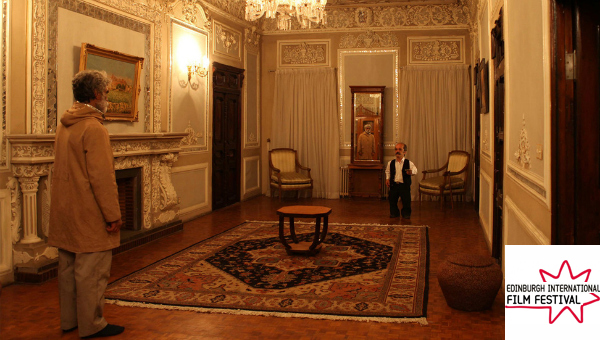 TABOOR opens on a wiry middle-aged man (Mohammad Rabbanipour), his concave chest dotted with bruises. As he wakes in his small room, the walls covered in silver foil, he puts on what will be his outfit for the bulk of the film: a silver foil jumpsuit and crash helmet. This sequence of him dressing has an intense intimacy, the sounds of rubbing fibres and crinkling foil feeling uncomfortably close.
TABOOR opens on a wiry middle-aged man (Mohammad Rabbanipour), his concave chest dotted with bruises. As he wakes in his small room, the walls covered in silver foil, he puts on what will be his outfit for the bulk of the film: a silver foil jumpsuit and crash helmet. This sequence of him dressing has an intense intimacy, the sounds of rubbing fibres and crinkling foil feeling uncomfortably close.
In one of the more eventful scenes, the man visits a dilapidated house, undresses and places a metal bucket on his head.
We follow this unnamed protagonist as he goes about the various activities of his nocturnal existence. Though we learn more about the city and the world this man inhabits, an ambiguity remains as to where and when it actually is. The broken-down machinery and empty streets, as well as the cockroach problem, suggest a near-future world in decline: perhaps winding down following some low-key catastrophe, perhaps just the isolated reality of an ill man leading a nocturnal life.
The reason for the man’s unusual clothing is partly explained in an admirably simple and effective scene. The camera falls on a steak as it cooks, and as it contracts and squirms, the juices spitting and bubbling, the sustained focus recasts it as something akin to a Rick Baker special effect. The comparison is then made between the steak and what is happening to the man’s body due to an unexplained microwave bombardment. This recasting of the everyday as something more than ordinary is a continued theme of the film. We are shown areas we wouldn’t usually encounter or think twice about: service tunnels and fire escapes shot in abstract ways, making them seem fresh and oddly beautiful. These complex, utilitarian structures gain a ruined grandeur, making the man’s non-adventures seem like some great labours of myth.
… relentless low hums and electrical buzzing, the high-pressure creaks and snaps of hinges and handles …
In one of the more eventful scenes, the man visits a dilapidated house, undresses and places a metal bucket on his head. A person off-screen fires at his body with an air gun, and the reason for his bruising becomes apparent: this is clearly something he does regularly. Our intimate immersion in this man’s life continues throughout the film, until a curiously cathartic scene where he takes a ride on a mine cart simulator. Both the garish exterior of this archaic piece of technology and the scene itself feel rather out of place, and almost takes the viewer out of the film. Though the scene slightly outstays its welcome, the low-key absurdity and the atmosphere of isolation fit in perfectly with Vakilifar’s melancholic anti-thrills.
The tone of the film is accentuated by the excellent soundtrack. The relentless low hums and electrical buzzing, the high-pressure creaks and snaps of hinges and handles, create a warm, drowsy atmosphere that accentuates the sparse dialogue. TABOOR’s episodic structure has a curious momentum and consistency, and though it’s not exactly the rollercoaster experience of the simulator, it’s a rewarding film-going experience with a unique cumulative atmosphere of compressed elegiac sadness.
The UK premiere of TABOOR took place at the Edinburgh International Film Festival 2013.
httpvh://youtu.be/2WFFeNjsvkY


One thought on “Taboor”
Comments are closed.